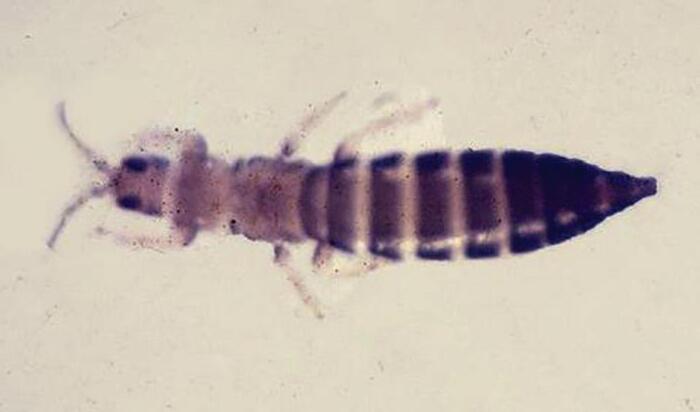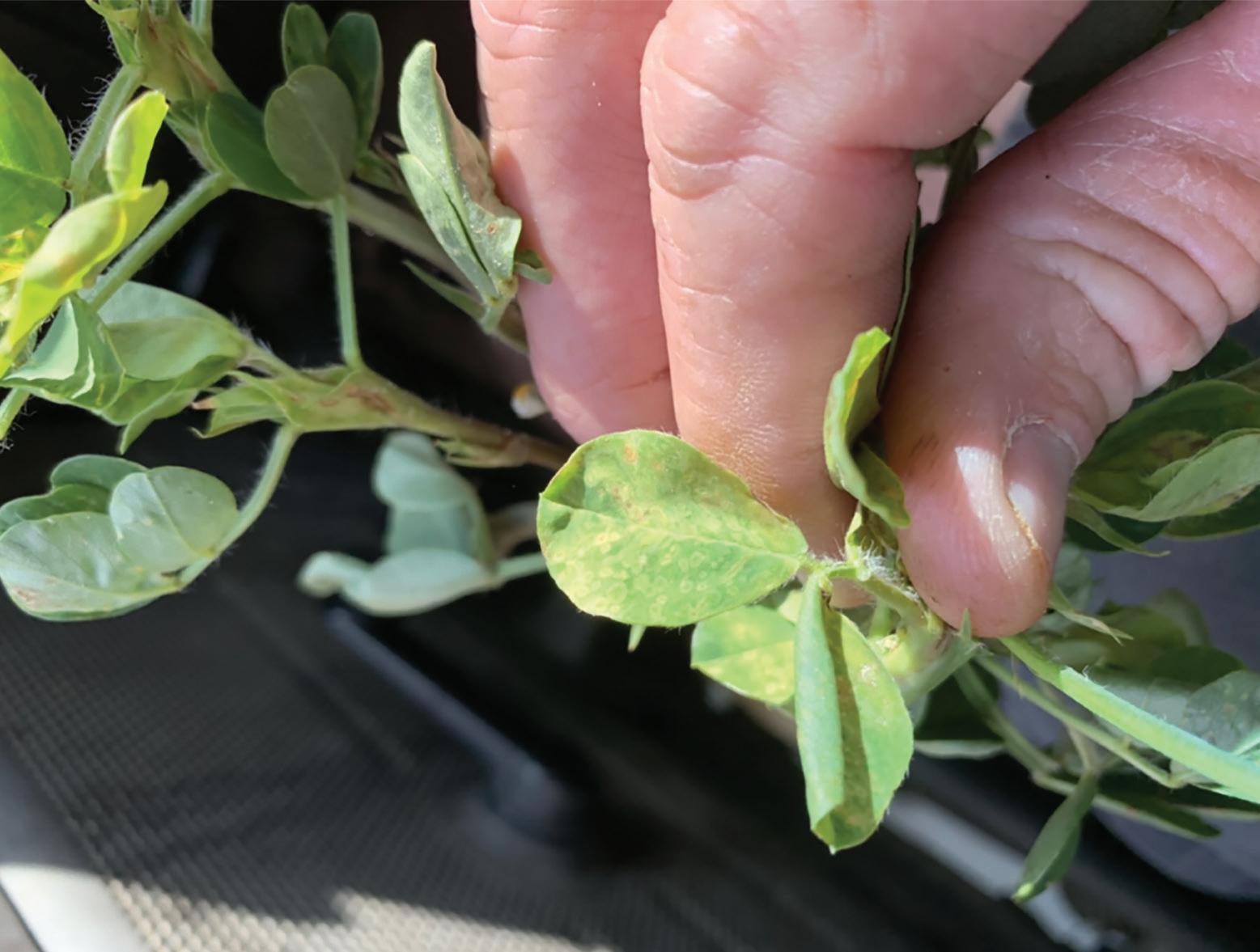
6 minute read
Thrips And TSWV
By Amanda Huber
Since Tomato Spotted Wilt Virus has been a problem in fields, it has always fluctuated in severity, says University of Georgia research plant pathologist Albert Culbreath. In 2022, losses to the virus across the Southeastern United States were estimated to be 7% and had a significant impact on a majority of acres planted to peanuts in the region.
“In my own plots and in grower fields I saw or was in, there was a lot of spotted wilt. It really took me back to 1997,” Culbreath says.
Although researchers and Extension do not have a definitive answer for the increase in TSWV, they do know pressure has been on the rise.
Why Thrips Matter:
• Thrips will be present in every field every year.
“The varietal resistance we have has never been a complete level of resistance as in approaching immunity,” Culbreath says.
• Thrips feeding injury reduces yield.
• Thrips transmit Tomato Spotted Wilt Virus.
“The resistance we have in our varieties has not been overcome, but it can be overwhelmed,” he says. “The resistance is still viable and there have not been any genetic changes in the virus or varieties, but the amount of inoculum that our varieties have been exposed to has led to greater losses.
“As bad as spotted wilt was in spots in 2022 with our resistant varieties,” Culbreath says, “I shudder to think of what it might look like if we were still dependent on varieties like Florunner or SunOleic 97R, which were susceptible to the virus.”
Thrips Must Catch The Virus To Spread It
To understand TSWV, it is necessary to understand the role of thrips.
“Thrips matter, and I want you to understand why thrips matter,” says UGA Extension entomologist Mark Abney. “Thrips have to acquire the virus by feeding on an infected plant in the larval stage to be able to transmit it to another plant, such as peanut.”
However, thrips are basically everywhere, he says. They can come from your neighbor’s field or the next state – pretty much anywhere.
“Thrips are 1- to 2-millimeter-long insects. There are two species we see in peanuts: tobacco and western flower thrips. But, it is mostly tobacco thrips that come out of the ground and get onto our seedling peanuts, that cause damage you see on seedlings and are responsible for most of the TSWV that causes yield loss.”
What do thrips eat?
“Almost anything green,” Abney says. “They have a very wide host range and can complete their life cycle in two to three weeks.”
Watching The Weather
We can do a pretty good job predicting intensity and timing of thrips dispersal. Why? Those are regulated by weather, Abney says.
“Warm winters generally mean more thrips. But rainfall kills immature thrips. If we have warm weather but lots of rain in February and March, we may have fewer thrips. The best-case scenario is cold and wet.
University of Georgia plant pathologist Bob Kemerait says we are in for a third year of a La Niña weather pattern. A La Niña refers to the cooling of ocean surface temperatures in the Pacific Ocean. What it means for the Southeastern United States is warmer temperatures and reduced rainfall.
“Three consecutive winters of La Niña, which is characterized by warmer and drier than normal,” Kemerait says. “It doesn’t mean it will never get cold, nor that it’s not going to rain. It just means above-average temperatures and below-average rainfall.”
Warmer temperatures and less rainfall mean more thrips.
“If La Niña trends continue, and it’s warmer and drier, that will increase the risk of thrips populations. In La Niña winters, we tend to see more TSWV, and we’re in a run of three in a row.”
Don’t Make The Problem Worse
With a wide range of hosts, Abney says thrips will overwinter in anything green. So, what triggers their move into peanuts? He offers the following example.
To Reduce Thrips
“It’s April and temperatures are in the 60s, then all of a sudden the temperature shoots up into the 80s for four or five days in a row. Winter annual weeds start to die back. Thrips don’t give up and die. They fly to whatever tender green plant they can find, which is often seedling cotton or peanuts.
“Knowing thrips flights is more important for cotton than peanut, but we can predict the intensity of thrips and TSWV. If you don’t protect your peanuts from TSWV, you are more likely to get it.”
Abney says you can control thrips, but you can’t kill enough to keep them from being a problem or infecting your field. And, you can also make the situation worse.
“If you plant peanut on May 1, then in a few days burn down a nearby field, where are those thrips going to go as those plants die and turn brown? They will move onto green peanut seedlings. So, you can make problems worse.”
What can you do in this case? Abney says an option is to add Orthene to the burn down.
“A lot of times, I can go into a field and find thrips the very first day the first green leaf comes out of the ground,” he says. “They are always out there.”
Always Meeting The Threshold
On their own, Abney says, thrips will suck the juice from your seedling plants, causing some yield loss. Because of this, a threshold was developed. If you scout peanuts 14 days after planting and find two or more thrips per plant, you need to treat. But Abney says you’ll meet threshold nearly every single time. So, what does he recommend?
“Because most every field would meet a threshold of two or more thrips at 14 days after planting, I recommend you
The Effect of Peanut Rx Factors On Thrips:
put an insecticide at plant to kill thrips. If TSWV went away tomorrow, I would tell you to control thrips because you will preserve yield and save money in the end,” he says.
But the biggest part of the story is TSWV. Going into 2023, Abney says there are no new treatments for thrips or spotted wilt. However, just because there is nothing new, does not mean there’s nothing you can do.
“TSWV has been around nearly 40 years and bad for the past 30 years. Those things we figured out in 1996 still work. It doesn’t work perfectly – nothing does. But it can help.”
Critical Factors Affecting Thrips
Those “things” figured out in 1996, as Abney refers to, are the basis of Peanut Rx. Although the risk index is about TSWV, plus white mold and leaf spot, it covers a lot of factors that influence thrips, the vector of the virus.
Peanut Rx starts with plant population, but the affect on thrips is unknown, Abney says. However, it is well known that there will be more virus with skippy stands.
“The way I look at plant population, if I have a million thrips in the air and 500,000 plants, those thrips land, and I have two thrips per plant. But, if I have a million thrips and a million plants, and the thrips land, then I have one thrip per plant. I would rather have one thrip per plant than two.”
Since at-plant insecticide is recommended, it has a major impact on thrips. Row pattern only affects the way thrips find their host; otherwise, it has an unknown impact.
Planting date and tillage both have a significant impact on thrips pressure, Abney says.
“How do thrips find their host? They look for the green plant on bare ground. They don’t tend to land on a green plant with residue around it. It’s not their preferred host. Tillage matters,” Abney says. The last Peanut Rx factor, Classic herbicide, has no effect on thrips.
Thrips Matter, As Does The At-Plant Insecticide
Using an at-plant insecticide has a major effect on thrips pressure. In grower surveys conducted by UGA Extension agents, Abney says they found that nearly 80% of acres were treated with an at-plant insecticide.
“That’s good, but it tells me that 20% of acres are at increased risk of losses from TSWV,” he says.
Often, there are options of pesticides that can be used nearly interchangeably. In the case of reducing TSWV pressure, one product stands alone: Thimet.
“What should you use in-furrow?
Fifty percent of those 80% using an at-plant insecticide use Thimet,” Abney says. “Thimet does two things: it kills thrips, and it reduces the risk of TSWV.”
Another insecticide used is imidacloprid.

Abney says this product reduces the risk of loss due to thrips feedings. However, it does not reduce any risk of loss due to TSWV, and, in fact, it can increase the risk of TSWV.
“It says this directly on the label. It doesn’t always make it worse, but it can,” he says.
Another product is AgLogic.
Abney says, “AgLogic is actually the best thrips-killing product available, but it doesn’t reduce the risk of TSWV. It’s not just about killing thrips. Sometimes you’ll see a reduction in spotted wilt, but not much.”
Final Recommendation
What does Thimet do?
“It induces host defense response to the virus,” Abney says. In other words, it turns on the plant’s immune system.
“When you take a variety that has some resistance, like Georgia 06-G and you put Thimet under it, you give that plant more resistance. Do we make it immune? No. We can’t expect it to be immune. But we make it more resistant,” he says.
Other insecticides don’t do this.
In a survey of fields by UGA Extension agents, Abney says that in fields using Thimet, 9% TSWV was found. In those using imidacloprid, 19% TSWV was found. The rule of thumb for losses is 20 pounds for every 1% TSWV infection.
In 2023, Abney says producers should plant a resistant variety in the low-risk window, which is May 11 to May 31, and apply Thimet in-furrow to reduce thrips pressure and the risk of TSWV. PG












